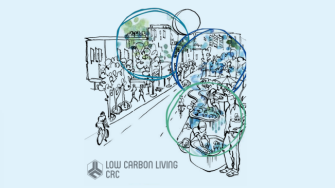Program 2: Low Carbon Precincts

This project evaluated urban precinct assessment tools to identify the level of collaboration, standardisation of information, data and processes required to develop a 21st century design tool. The aim of such a tool is to evaluate the carbon imprint and sustainability of current and future built environments, and to provide a common environmental rating system for urban precincts. A standardised system will improve the current fragmented approach to precinct assessment.
Prof Peter Newton, Swinburne University
Complete
12/2012 to 11/2013
- Publications
- Posters
- Partners
Peer Reviewed Research Publications
RP2001: Journal Article: Low-carbon precincts for low-carbon living
Evidence continues to mount concerning the contribution that carbon emissions from human activity are making to climate change, the costs that this will impose on future generations if unabated and the challenging GHG mitigation targets and strategies required to minimize temperature increase. There are multiple pathways available for the decarbonization of modern societies and they tend to fall under three principal categories: technological change, sustainable urban design and behavior change. All are necessary and require transformational change from current practice....
Read the full artilce here: https://doi.org/10.4155/cmt.13.72
CRCLCL Project Reports
RP2001: Performance Assessment of Urban Precinct Design: A Scoping Study
Significant advances have been made over the past decade in the development of scientifically and industry accepted tools for the performance assessment of buildings in terms of energy, carbon, water, indoor environment quality etc. For resilient, sustainable low carbon urban development to be realised in the 21st century, however, will require several radical transitions in design performance beyond the scale of individual buildings. One of these involves the creation and application of leading edge tools (not widely available to built environment professions and practitioners) capable of being applied to an assessment of performance across all stages of development at a precinct scale (neighbourhood, community and district) in either greenfield, brownfield or greyfield settings. A core aspect here is the development of a new way of modelling precincts, referred to as Precinct Information Modelling (PIM) that provides for transparent sharing and linking of precinct object information across the development life cycle together with consistent, accurate and reliable access to reference data, including that associated with the urban context of the precinct.
Neighbourhoods are the ‘building blocks’ of our cities and represent the scale at which urban design needs to make its contribution to city performance: as productive, liveable, environmentally sustainable and socially inclusive places (COAG 2009). Neighbourhood design constitutes a major area for innovation as part of an urban design protocol established by the federal government (Department of Infrastructure and Transport 2011, see Figure 1). The ability to efficiently and effectively assess urban design performance at a neighbourhood level is in its infancy.
rp2001 performance assessment urban precinct design final (3982411 PDF)
CRCLCL Project Posters
Research Snapshot Poster - RP2001
Research Snapshot A3 size poster from Participants Annual Forum 2014
Research Snapshot Poster - RP2001 (241215 PDF)
Partners on this project
- Sydney Water
- Swinburne University of Technology
- Renewal SA – Government of South Australia
- UrbanGrowth NSW
- HASSELL
- CSIRO
- Sydney Smart Innovation Lab Australia
- AECOM – Imagine it. Delivered.